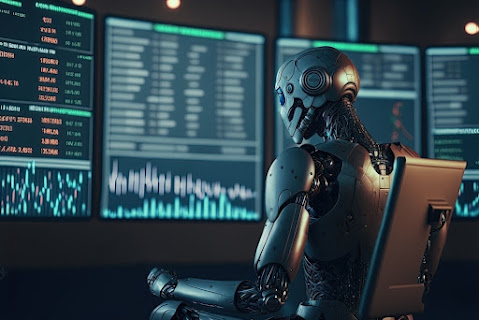Introduction
Algorithmic trading or Algo trading is a method of executing trades using computer programs. Algo trading is also known as black-box trading, automated trading, or robotic trading. The system follows a set of rules and algorithms that are predefined by the trader, and the system can execute trades automatically based on these rules. The aim of algo trading is to make trading faster, more accurate, and more efficient. The use of Artificial Intelligence (AI) and Machine Learning (ML) in algo trading has revolutionized the industry.
Role of AI and ML in Algo Trading
Predictive Analytics
AI and ML are used to predict the behaviour of markets and assets, which helps traders make informed trading decisions. Predictive analytics can analyze large amounts of data and identify patterns that are not easily visible to humans. This helps traders anticipate market movements and take advantage of opportunities.
Pattern Recognition
AI and ML can be used to recognize patterns in market data. These patterns can indicate opportunities for profitable trades. The ability to recognize patterns in data is critical for algo trading because it helps traders identify trading signals and make informed decisions.
For example, pattern recognition can be used by a trader to spot a trend in the stock market. The trader can buy stocks if the market is heading up, and sell stocks if the market is trending down.
Sentiment Analysis
AI and ML can be used to analyze social media and news feeds to determine the sentiment of the market. This information can be used to make trading decisions. For example, if the sentiment is negative, traders may decide to sell their positions to avoid losses.
Sentiment analysis can also be used to analyze the sentiment of a particular company or industry. If the sentiment is positive, traders may decide to invest in the company or industry.
Automation
AI and ML are used to automate the trading process. This includes analyzing data, identifying patterns, and executing trades. Trading is faster because of automation, which also makes mistakes by humans impossible.
For example, traders can use automated trading systems to automatically buy and sell stocks according to prescribed regulations. Compared to human traders, algorithms can evaluate data and execute trades faster.
Risk Management
AI and ML can be used to manage risk in trading. This includes identifying potential risks and taking steps to mitigate them. For example, if a trader has a position in a risky asset, AI and ML can be used to monitor the asset and automatically sell when the risk becomes too high.
Benefits of AI and ML in Algo Trading
Speed and Efficiency
AI and ML algorithms can analyze data and execute trades faster than humans. This shortens the trading process and enables traders to seize opportunities as they present themselves.
Increased Accuracy
AI and ML algorithms are more accurate than humans at analyzing data and identifying patterns. This reduces the possibility of human error and improves the accuracy of trading decisions.
Risk Management
AI and ML algorithms can be used to manage risk in trading. This includes identifying potential risks and taking steps to mitigate them. This reduces the possibility of losses and improves the overall profitability of trading.
Improved Decision Making
AI and ML algorithms can analyze data and provide traders with insights that are not easily visible to humans. This improves the quality of trading decisions and increases the profitability of trading.
Challenges of AI and ML in Algo Trading
Data Quality
The quality of data used to train AI and ML algorithms is critical for their effectiveness. If the data used is incomplete, biased, or inaccurate, the algorithms may produce inaccurate results, leading to poor trading decisions. Therefore, it is crucial to ensure that the data used for AI and ML in algo trading is of high quality.
Overfitting
Overfitting occurs when an AI or ML algorithm is trained on a specific set of data and becomes too specialized for that data. As a result, the algorithm may not be able to generalize to new data, leading to poor trading decisions. To avoid overfitting, it is essential to use a diverse set of data when training algorithms.
Model Complexity
AI and ML algorithms can be complex, making it difficult for traders to understand how they work. This can lead to a lack of trust in the algorithms and hesitation to use them in trading decisions. Therefore, It is crucial to create models that are simple to comprehend and interpret.
Regulatory Challenges
The use of AI and ML in algo trading is relatively new, and regulations surrounding their use are still evolving. Traders need to ensure that their use of AI and ML in trading complies with regulatory requirements.
Conclusion
The use of AI and ML in algo trading has revolutionized the industry. It has increased the speed and efficiency of trading, improved the accuracy of trading decisions, and enabled better risk management. However, there are also challenges associated with the use of AI and ML in algo trading, such as data quality, overfitting, model complexity, and regulatory challenges.
Despite these challenges, the benefits of AI and ML in algo trading outweigh the risks. The use of AI and ML in algo trading is likely to continue to grow, and traders who embrace these technologies are likely to have a competitive advantage in the market.
A1 Advance Infotech, being an algo trading software company, can benefit greatly from the use of AI and ML in its trading systems. By incorporating these technologies, the company can increase the speed and efficiency of its trading, improve the accuracy of its trading decisions, and enable better risk management.

